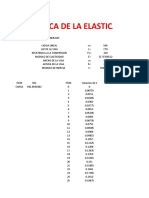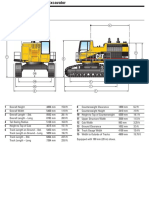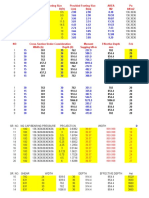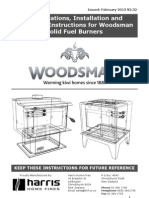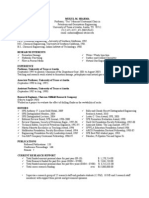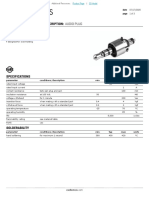Warning! Fork Hook: Forklift Jib Instruction Manual
Warning! Fork Hook: Forklift Jib Instruction Manual
Uploaded by
EmolNZCopyright:
Available Formats
Warning! Fork Hook: Forklift Jib Instruction Manual
Warning! Fork Hook: Forklift Jib Instruction Manual
Uploaded by
EmolNZOriginal Title
Copyright
Available Formats
Share this document
Did you find this document useful?
Is this content inappropriate?
Copyright:
Available Formats
Warning! Fork Hook: Forklift Jib Instruction Manual
Warning! Fork Hook: Forklift Jib Instruction Manual
Uploaded by
EmolNZCopyright:
Available Formats
FORKLIFT JIB
INSTRUCTION MANUAL
MPN: FMJ3
SKU: 194118
UPC: 737069522203
WARNING!
Fork Hook READ AND FOLLOW THIS LABEL AND SUPPLIED
INSTRUCTION SHEET BEFORE USING
Capacity: 5500lbs
DO NOT USE TO LIFT PERSONNEL
DO NOT LEAVE SUSPENDED LOAD UNATTENDED
Titan Distributors Inc. 1 800-605-8241
141 Eastley St. Ste. 113 www.palletforks.com
Collierville, TN 38017 info@titandistributorsinc.com
The Titan Forklift Jib is installed on the forklift by inserting both forks fully into the fork pockets so that the rear
of the Jib is against the back of the fork. If equipped with “Fork Pin Tabs”, insert locking pins behind the heel of each
fork and secure with hair pins. If equipped with a “safety chain”, wrap chain around a strong part of the forklift carriage
keeping chain as level as possible. Chain angle must not exceed 45°. Take as many wraps as needed to take up the
slack, then hook the chain back onto itself making sure the open part of the grab hook is pointing down.
General Precautions
1. Forklift operator must be properly trained and have required certifications.
2. Before using the Jib check to see that it is properly secured to the forklift as described above and that the shackles
and hooks are properly secured to the Jib and screw pins are tight.
3. Determine that the loads to be handled are within the capabilities of the forklift. Keep in mind that rated capacities
will likely decrease when the boom is in a raised position, or when the mast is tilted forward, or in the case of
telehandlers, when the boom is extended.
4. Forks should be level or tipped upward (never down below level) when using the jib.
5. Do not pull loads. Booms designed for vertical lift only.
6. The load should always be carried low and kept from swinging using tag lines as necessary. When a load is raised;
extreme caution should be exercised as the forklift is far more vulnerable to tipping with a raised load.
7. Any time the load is raised make sure the forklift is on level, firm footing.
8. Check Jib boom extension lock pin to make sure it is functioning properly. Make sure spring has proper tension to
keep pin engaged.
9. Refer to the forklift operator’s manual for more information on handling elevated loads as well as information for
safe and proper forklift operation.
10. Each time before use check all shackles and hooks, make sure cotter pins are installed properly. And shackle screw
pins are tight.
11. Always comply with all local, state, and federal Safety regulations.
12. DO NOT USE JIB IN ANY WAY TO CARRY OR ELEVATE PERSONNEL!
Forklift Load Capacities
Care must be taken not to exceed the capacity of the forklift. When handling a load with the jib, the load center is
moved out away from the standard forklift load center (typically 24”) which significantly reduces the lift capacity of the
forklift. In addition the weight of the jib has been added which also further reduces forklift capacity.
There are two ways to determine the reduced lift capacities when using the Titan Forklift Crane. The most preferable
and most accurate is to contact the forklift manufacturer or certified professional engineer for a de-rated load capacity
chart. If this is not available, simple foot pound calculations can be made to estimate the reduced load capacities. For
example, a forklift that is rated in the desired lift position at 8000 lbs (at a 2 ft load center) has a lift capacity of 16000
foot lbs. (2 ft X 8000 lbs.) To calculate the forklift de-rated capacity when using our Titan Forklift Crane at its maximum
extension of 12’3”, simply deduct the 2093 foot lbs for the weight of the jib (cg of 4.63 ft x 452 lbs weight of jib = 2093
ft lbs) from the 16000 ft lbs and then divide the remainder by the new 12.25 foot load center, which gives us 1135 lbs
de-rated lift capacity for an 8,000 lb Forklift with the Titan Forklift Crane extended. The chart below shows these
reduced capacity calculations for several forklift capacities.
1. Determine Forklift Capacity (@ 24” load center) from your forklift’s
load chart for applicable fork & mast position.
2. Bold figures at top of columns represent your forklift’s capacity at the
relevant fork & mast position.
Hook Position Distance Horz. CG 3. Read de-rated capacity when using Jib in respective column.
Inches 2,000 3,000 4,000 5,000 6,000 8,000 10,000 12,000
1 2’6” 36.31 1057 1857 2657 3457 4257 5857 7457 9057
2 3’3” 36.31 813 1428 2044 2659 3275 4505 5736 6967
3 4’0” 36.31 661 1161 1661 2161 2661 3661 4661 5661
4 4’9” 36.31 556 977 1398 1819 2240 3082 3925 4767
5 5’6” 36.31 480 844 1208 1571 1935 2662 3389 4117
6 6’3” 36.31 423 743 1063 1383 1703 2343 2983 3623
7 7’0” 36.31 377 663 949 1234 1520 2092 2663 3234
8 7’9” 40.20 341 599 857 1115 1373 1889 2405 2921
9 8’6” 42.25 311 546 781 1016 1252 1722 2193 2664
10 9’3” 45.00 285 502 718 934 1150 1583 2015 2448
11 10’0” 48.65 219 419 619 819 1019 1419 1819 2219
12 10’9” 50.00 203 389 576 762 948 1320 1692 2064
13 11’6” 52.17 190 364 538 712 886 1234 1581 1929
14 12’3” 55.57 178 342 505 668 832 1135 1485 1811
30
39
48
57
66
75
84
93
102
111
120
129
138
147
Length Positions (Inches) 30 39 48 57 66 75 84 93 102 111 120 129 138 147
Capacity (lbs) 6614 5070 4112 3457 2983 2624 2339 2112 1927 1770 1638 1523 1429 1336
You might also like
- Solution Manual For Introduction To Fluid MechanicsDocument1,428 pagesSolution Manual For Introduction To Fluid MechanicsSilvio Roberto Attanasio100% (6)
- Highway Mini Nest Circular Dated 24-01-2018Document5 pagesHighway Mini Nest Circular Dated 24-01-2018Shalini Borker100% (1)
- Depth (FT) ROP (FT/HR) WOB (1000lbs) RPM Densitas (PPG)Document3 pagesDepth (FT) ROP (FT/HR) WOB (1000lbs) RPM Densitas (PPG)Zulfandi FandhiNo ratings yet
- 3 Demag CC2800-1Document6 pages3 Demag CC2800-1Jon Csehi100% (2)
- Fatigue Failure of A Rear Axle Shaft of An AutomobileDocument10 pagesFatigue Failure of A Rear Axle Shaft of An AutomobileEmolNZNo ratings yet
- Storey Shear CalculationDocument9 pagesStorey Shear CalculationAkhileshNo ratings yet
- Spec CraneDocument4 pagesSpec CraneRyo ArdhiNo ratings yet
- Bridon Tiger 24 LS PI DatasheetDocument1 pageBridon Tiger 24 LS PI DatasheetAnonymous ntE0hG2TPNo ratings yet
- Railway Bridge DetailDocument15 pagesRailway Bridge Detailtarun palNo ratings yet
- Preliminary Design of ColumnDocument4 pagesPreliminary Design of ColumnAkhileshNo ratings yet
- Hydrostatic CalculationDocument102 pagesHydrostatic CalculationJonas EboraNo ratings yet
- Sec 8Document14 pagesSec 8stonzedd2No ratings yet
- WeightDocument35 pagesWeightYan Naing ShinNo ratings yet
- SK575Document4 pagesSK575Néstor Villanueva GutiérrezNo ratings yet
- Datasheet 6x36 Galvanised WS Fibre CoreDocument1 pageDatasheet 6x36 Galvanised WS Fibre CoreEman SayedNo ratings yet
- CE20B065 Steel 6Document13 pagesCE20B065 Steel 6Machana vinay krishnaNo ratings yet
- Elastic ADocument48 pagesElastic AELIANA VALERIA CHINCHAY RANGELNo ratings yet
- Triangular StrandDocument2 pagesTriangular StrandMunifatul ArifaNo ratings yet
- Design DataDocument16 pagesDesign DataAmok BajracharyaNo ratings yet
- Hammerhead Tower Crane 35,200-70,500 Lbs. (16-32 T) Lifting CapacityDocument5 pagesHammerhead Tower Crane 35,200-70,500 Lbs. (16-32 T) Lifting CapacityAseb SbdNo ratings yet
- Universal Beams PDFDocument2 pagesUniversal Beams PDFbrodieNo ratings yet
- QS816VDocument1 pageQS816VSONNo ratings yet
- MINT - 10 1 Bevezetes NORBAR Oldal9 10Document2 pagesMINT - 10 1 Bevezetes NORBAR Oldal9 10Ibrahim SaidNo ratings yet
- Hangcha WRS14Document8 pagesHangcha WRS14Almacen MoserinNo ratings yet
- Diseño C1-25x45 (C6)Document11 pagesDiseño C1-25x45 (C6)Jose Mayner GarciaNo ratings yet
- BC It Atf 650 XLDocument4 pagesBC It Atf 650 XLThein Htoon lwinNo ratings yet
- BC It Atf 650 XLDocument4 pagesBC It Atf 650 XLThein Htoon lwinNo ratings yet
- Ram Spec s-28f9845Document2 pagesRam Spec s-28f9845Justine Kei Lim-OrtegaNo ratings yet
- RFJ FjpoeDocument27 pagesRFJ FjpoeNate JamesNo ratings yet
- Dunhambush Centrifugal Chiller Installation ManualDocument1 pageDunhambush Centrifugal Chiller Installation ManualEbenezer NatoplagNo ratings yet
- PreparationDocument28 pagesPreparationAitbenahmed HibaNo ratings yet
- Present Value TableDocument2 pagesPresent Value Tablemanoj262400/2No ratings yet
- Localidades Poblacion Total Habitantes Total Departamento 1265213 Arequipa Metropolitana 1053333Document6 pagesLocalidades Poblacion Total Habitantes Total Departamento 1265213 Arequipa Metropolitana 1053333Agustín Aguilar HuamanNo ratings yet
- CIV 305 Hydrology I - Tutorials T13Document28 pagesCIV 305 Hydrology I - Tutorials T13Adna RamićNo ratings yet
- Hooke's Law ExperimentDocument17 pagesHooke's Law ExperimentScribdTranslationsNo ratings yet
- Math ModelDocument25 pagesMath ModelRyan CarlverttNo ratings yet
- HeijunkaDocument10 pagesHeijunkanasth98No ratings yet
- Factor AnalysisDocument7 pagesFactor AnalysisMeaadNo ratings yet
- Roots RAM Rotary Positive Blowers: SpecificationsDocument2 pagesRoots RAM Rotary Positive Blowers: SpecificationsAlberto Velosa RoaNo ratings yet
- GA Examples-Excel Templ - ConstrDocument756 pagesGA Examples-Excel Templ - ConstrIlham BadarrudinNo ratings yet
- Proving Ring Calibration CertificateDocument12 pagesProving Ring Calibration CertificateRaza Mutahir100% (5)
- Pressure Conversion Wet Well Intake Pipe Sizing: 173.4 Amps 1.24x1.25x65a + 65A + 7.6ADocument2 pagesPressure Conversion Wet Well Intake Pipe Sizing: 173.4 Amps 1.24x1.25x65a + 65A + 7.6AMark Joey David100% (1)
- Water Structure Design Task Group 3Document27 pagesWater Structure Design Task Group 3MUHAMMAD TRIYONO PRATAMA BAHAR -No ratings yet
- Bunker Calculation-NmdcDocument23 pagesBunker Calculation-NmdcChetan SukteNo ratings yet
- Laboratory Exercise No. 5 Rheological PropertiesDocument16 pagesLaboratory Exercise No. 5 Rheological PropertiesANIME CHANNo ratings yet
- Roll No 14 EE Experiment No. 10Document9 pagesRoll No 14 EE Experiment No. 10Asim AwanNo ratings yet
- XCMG 75 Tons Truck Crane QY75KDocument4 pagesXCMG 75 Tons Truck Crane QY75KZul FachmiNo ratings yet
- C045887Document6 pagesC045887Davyda VedaNo ratings yet
- Perhitungan Penentuan Alternatif Produk Terbaik Dengan Metode TOPSISDocument7 pagesPerhitungan Penentuan Alternatif Produk Terbaik Dengan Metode TOPSISkhoirunnisa120113No ratings yet
- Efa PDFDocument12 pagesEfa PDFNirdeshNo ratings yet
- Caso IOSR CARACTERIZACIÓNDocument48 pagesCaso IOSR CARACTERIZACIÓNsandruka605No ratings yet
- Balance GeneralDocument1 pageBalance GeneralMinxin Srl Chatarra DE FierroNo ratings yet
- Magellan Wire RopeDocument20 pagesMagellan Wire RopeSaeed MohebbiNo ratings yet
- Lampiran 1 Tabel Distribusi Z Luas Daerah Dari 0 Ke ZDocument4 pagesLampiran 1 Tabel Distribusi Z Luas Daerah Dari 0 Ke ZVira PraditaNo ratings yet
- Measurements For Anchor-Chain and AccessoriesDocument4 pagesMeasurements For Anchor-Chain and AccessoriesOzata TersanesiNo ratings yet
- Ribbon BlenderDocument16 pagesRibbon BlenderamitNo ratings yet
- Tr = Tmax = G Ѳ J R L: Experiment of Torsion testing machineDocument5 pagesTr = Tmax = G Ѳ J R L: Experiment of Torsion testing machineAyuguNo ratings yet
- Comb. FOOTINGDocument5 pagesComb. FOOTINGSham SuriNo ratings yet
- Sac7000 - Jib & LuffingDocument1,004 pagesSac7000 - Jib & Luffingmongelguindastes2023No ratings yet
- MTN TablesDocument24 pagesMTN TablesPratham JiwananiNo ratings yet
- 2250 Heavy Lift Wire Rope Specifications 8025 ADocument3 pages2250 Heavy Lift Wire Rope Specifications 8025 AAmpera marzelaNo ratings yet
- United States Census Figures Back to 1630From EverandUnited States Census Figures Back to 1630No ratings yet
- X-Ing (Xiangshanxian) Linear Actuator Co.,LimitedDocument4 pagesX-Ing (Xiangshanxian) Linear Actuator Co.,LimitedEmolNZNo ratings yet
- Media 2618 Donn-Technical-BrochureDocument28 pagesMedia 2618 Donn-Technical-BrochureEmolNZNo ratings yet
- Hynds Oil and Grit Interceptor SW6Document4 pagesHynds Oil and Grit Interceptor SW6EmolNZNo ratings yet
- Ducted Central Gas Heating: The Effective Way To Heat Your Whole HomeDocument9 pagesDucted Central Gas Heating: The Effective Way To Heat Your Whole HomeEmolNZNo ratings yet
- Aquastop: Cement Based Waterproof Slurry Coating SystemDocument3 pagesAquastop: Cement Based Waterproof Slurry Coating SystemEmolNZNo ratings yet
- BMW 5 Series SedanDocument23 pagesBMW 5 Series SedanEmolNZNo ratings yet
- The BMW 5 Series.: July 2019Document17 pagesThe BMW 5 Series.: July 2019EmolNZNo ratings yet
- Brius Gas Installers-ManualDocument36 pagesBrius Gas Installers-ManualEmolNZNo ratings yet
- 07306180Document40 pages07306180EmolNZNo ratings yet
- Viking Installation m2730066 - F20543Document12 pagesViking Installation m2730066 - F20543EmolNZNo ratings yet
- 50 KG Head Hardened Rail: RT 23 HHDocument2 pages50 KG Head Hardened Rail: RT 23 HHEmolNZ100% (1)
- Heating Owners Manual Feb 2012Document28 pagesHeating Owners Manual Feb 2012EmolNZNo ratings yet
- Construction Worksafe ManualDocument242 pagesConstruction Worksafe ManualTir Dan Knight100% (2)
- Woodsman-Installation Instructions Flare DraftDocument22 pagesWoodsman-Installation Instructions Flare DraftEmolNZNo ratings yet
- Woodsman Brochure 2013Document9 pagesWoodsman Brochure 2013EmolNZNo ratings yet
- Woodsman-Installation Instructions Flare DraftDocument22 pagesWoodsman-Installation Instructions Flare DraftEmolNZNo ratings yet
- MS 01 149Document16 pagesMS 01 149EmolNZNo ratings yet
- 8-Bit Single-Chip Microcomputer With Ad Converter D78c10agq Nec Datasheet PDFDocument66 pages8-Bit Single-Chip Microcomputer With Ad Converter D78c10agq Nec Datasheet PDFAnonymous qWeFIfN90No ratings yet
- Mel 715: Gas Dynamics: A Passion of Doing Adventures Lead To A Hi-Fi Science and Technology!!!Document17 pagesMel 715: Gas Dynamics: A Passion of Doing Adventures Lead To A Hi-Fi Science and Technology!!!Arul SankaranNo ratings yet
- HG130 SM PDFDocument140 pagesHG130 SM PDFLucas Solon SolonNo ratings yet
- Resume09 2011Document29 pagesResume09 2011downloader1983No ratings yet
- Attachment 1 TOP Binder IndexDocument56 pagesAttachment 1 TOP Binder IndexSushil GuptaNo ratings yet
- ADE - The Future of MRODocument11 pagesADE - The Future of MROHarsleyNo ratings yet
- Scalable OpenSource StorageDocument31 pagesScalable OpenSource Storagejweb911No ratings yet
- Exit Clearance Form: Formulir Pengunduran DiriDocument1 pageExit Clearance Form: Formulir Pengunduran DiriSmandua Laung TuhupNo ratings yet
- Java RMIDocument20 pagesJava RMISampath SreeNo ratings yet
- Fire Hydrant DrawingDocument3 pagesFire Hydrant DrawingAshar HassanNo ratings yet
- 210-02 Rectilinear Motion of ParticlesDocument5 pages210-02 Rectilinear Motion of ParticlesReggy SeptaNo ratings yet
- Daily News: Pubudu Engineering Recives SL IEC 61439 For 'Powerlink' PanelsDocument1 pageDaily News: Pubudu Engineering Recives SL IEC 61439 For 'Powerlink' PanelsWalter MenesesNo ratings yet
- MODEL: SP-25502-OM Description: Audio Plug: FeaturesDocument4 pagesMODEL: SP-25502-OM Description: Audio Plug: FeaturesMarius BudauNo ratings yet
- Usa 10my Ud1800cs BBBDocument90 pagesUsa 10my Ud1800cs BBBSahaya Grinspan100% (5)
- Sponge Iron List 2001Document11 pagesSponge Iron List 2001bijayaceNo ratings yet
- Netcall ManualDocument7 pagesNetcall Manualnimisha rajuNo ratings yet
- Verona Medical Group - DENT-X EVA 2010Document4 pagesVerona Medical Group - DENT-X EVA 2010VeronaMedicalGroupYYNo ratings yet
- Sample 19544Document16 pagesSample 19544Sharad KumarNo ratings yet
- Planning Grid Leaving Cert Construction StudiesDocument4 pagesPlanning Grid Leaving Cert Construction Studiesapi-544280724No ratings yet
- Deep SeaDocument8 pagesDeep Seameor3705No ratings yet
- FMEA-Revised Veera Oct11e PDFDocument64 pagesFMEA-Revised Veera Oct11e PDFaman_ranhotraNo ratings yet
- Rittal WM Stainless Steel Enclosures 5 3078Document8 pagesRittal WM Stainless Steel Enclosures 5 3078tzuvela99No ratings yet
- Filter pc200Document2 pagesFilter pc200Importaciones e Inversiones CYHNo ratings yet
- Architectural Design IndraDocument7 pagesArchitectural Design IndraAshu JainNo ratings yet
- New Development With Supermarché - China Suzhou Sigmetal 2Document24 pagesNew Development With Supermarché - China Suzhou Sigmetal 2Koné Ibrahim KhalilNo ratings yet
- LightTools Illumination Design Software. Design, Analyze, Optimize and Deliver Illumination OpticsDocument8 pagesLightTools Illumination Design Software. Design, Analyze, Optimize and Deliver Illumination OpticsVinsmoke SanjiNo ratings yet
- TallerDocument6 pagesTallerMus GaveNo ratings yet
- Chapter Four: EntropyDocument17 pagesChapter Four: EntropyHussainNo ratings yet
















